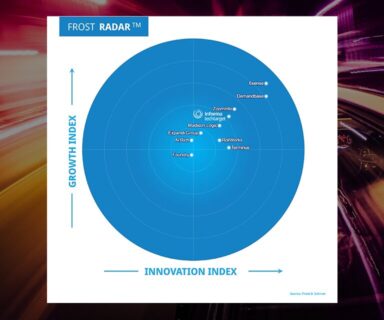EDITOR’S NOTE: This post is part of our “Smarter Sales and Marketing” series, a regular feature where technology marketing and sales experts will be sharing insight, tools, and best practices to help today’s leaders better integrate marketing and sales strategies for maximum success.
Most organizations’ value propositions are focused squarely on product or service features which, on the face of it, seems reasonable. But value is a tricky thing. Put on your “buyer hat” and consider this – which value description would you choose: the value delivered by the product, or the value experienced by the buyer? That may be obvious, but I can tell you that this is frequently not the same thing. I tend to get on a soap box about value propositions that exist in the vacuum of their own rhetoric (see what I mean?). But at the end of the day, we have to communicate value to our target audiences in a way that will actually stand out and resonate with them (not us).
What if you look at this dilemma through a social media lens? It’s hard to really know how to maximize a product/service focused value proposition socially, as we are told not to “sell” on social media per se. We are supposed to use it as a means of influencing, educating, informing and broadening the conversation. That definitely implies something other than a feature discussion!
First of all, you need to re-tune your value proposition in two important ways:
- Shift the focus from product/service to align with the buyer
- Create easily communicated value messages that are bite-sized for social media
Make It Modular
So by now, you might be saying to yourself, “We are all set, we have an elevator pitch.” Don’t be so quick to move straight to an elevator speech. It is part of the arsenal, but it isn’t everything. It definitely isn’t enough when you are trying to put together messaging. If you want a solid, consistent value message that can be used by both marketing and sales, and in every communication format, you need a value proposition platform that is modular and easy to customize for each format type. Starting with the value proposition statement itself, consider building three pieces that you can use together or separately.
- Customer Objective Statement (your target’s goal, challenge, issues, pain) 1-3 sentences
- Offer Statement (your specific offer to address #1) 1-3 sentences
- Differentiator (1 or 2 provable differences that address #1)
Yes – It IS all about number one. With each of these pieces, you can socialize by focusing posts, tweets, video, podcasts on each section, with an embedded call-to-action that leads to a piece of digital content, a webinar, a download, you name it. Consider spending blocks of time focusing on each one in social media – building the story with “crumbs” that your followers can consume as they move closer to your offering.
Back It Up
 One of the best ways to be sure your value proposition is credible is to back it up with clear, concise and specific value nuggets. Each of these nuggets can easily be “socialized” by focusing on them separately with additional content offered to dive deeper. Here are the pieces for the “back-up.”
One of the best ways to be sure your value proposition is credible is to back it up with clear, concise and specific value nuggets. Each of these nuggets can easily be “socialized” by focusing on them separately with additional content offered to dive deeper. Here are the pieces for the “back-up.”
- Value Drivers
- Quantification
- Credible 3rd Party Statements
The secret sauce to developing a good, ” socializable” value proposition is the selection of value drivers. These are a set of key words that net out the most important value points from the point-of-view of the buyers
They represent the areas that a buyer considers first when making a decision in your offer category. Value drivers are a great way to extend the value proposition, and to force you to net out the most important points. Your value drivers should come from your value proposition statement, or integrate easily with it.
Now is the time to think about what “value” do some of your key features bring to the buyer. Let’s say that I am considering purchasing an online software platform that gives me access to public relations announcements, social media posts, and other consumer-generated content so I can keep tabs on what our customers and the market is saying about my company. What are the value drivers that are in my head when I am in this buyer journey?
- Immediacy (I need the most up-to-date information available.)
- Measurement (How can I benchmark and report on how many mentions we get.)
- Relevance (I need to be sure the information I get back isn’t “junk.” )
I can use each value driver as a social media focus and be able to discuss and share why each is important, and point to resources and content that help tell that story.
The next piece of the modular approach is to provide quantification. This is about providing quantifiable information that backs up the importance of each value driver. This may take the form of statistics, research results, customer results, survey data – any way where there are numbers to back it up from a credible third party source. Finally, you need to add the last piece which is proof.
The frosting on the cake of your value proposition is always demonstrable, verifiable proof that your claims are valid. Each value drive is quantified, and proof is offered as the final back-up. Independent audit results, market analyst ratings and reports, customer quotes and testimonials, awards from industry organizations. These need to be all third-party sources, underlying the fact that others in your market have verified and stand with your value proposition claims. Each of these pieces can be offered singling or in tandem with the value driver. Individually each is a jumping off point for a piece of social media. They work extremely well in a well-defined social media campaign where you are streaming messages across a defined time frame and can deliver the story in a way that encourages following and engagement.
Now ask yourself how social your value proposition is today? Can you use it in a variety of ways easily and consistently? A little extra attention on the front end of value proposition development will put you and your team in a great place to be able to communicate your message in a social-friendly way and drive engagement and connection with your target audience.

An experienced salesperson and marketer, Lisa Dennis is president and founder of Knowledgence Associates, a sales and marketing consultancy. Pairing hands-on marketing and selling of information and high technology products and services, she understands what the customer imperative needs to be for communicating information about products and services to varied audiences. Lisa’s philosophy is that the core of successful marketing and sales initiatives is “doing the homework” – making sure that the information side of programs and campaigns are solid.
Prior to founding Knowledgence in 1997, she held publishing, product management and marketing/sales roles at Bolt Beranek and Newman, Thomson & Thomson (a member company of The Thomson Corporation), The Center for Business Intelligence, and World Congress. You can follow Lisa and Knowledgence on LinkedIn and Twitter.




